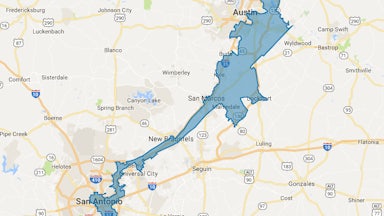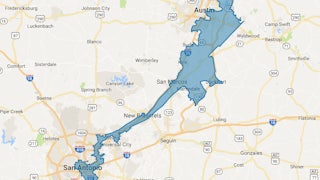The past few months have been rough for Texas—and for the Texas Republican Party in particular. Republicans in the state led the charge to overturn the 2020 election results, centering their anti-democratic arguments on fantasies of stolen ballots and smothered voices. Then a once-in-a-generation winter storm revealed the extent to which years-long GOP control had rotted the state’s infrastructure, providing a searing illustration of collapse that gripped the news cycle and the nation. (And leading to Senator Ted Cruz tucking tail for Cancun.) Just last week, Governor Greg Abbott—in a fit of “neanderthal thinking,” as President Joe Biden said—launched a premature lifting of the state’s mask mandate, setting the stage for new Covid-19 variants to wash across the population, the potential for new casualties in a pandemic the rest of the country is finally obtaining the upper hand over, and new reasons for voters who may be tilting in their partisan preferences to consider ousting the governor when he’s up for reelection in two years.
Perhaps unsurprisingly, the state’s GOP—mimicking its national counterpart—has responded to these cascading failures not with sound policy proposals but with a bushel of distractions related to America’s never-ending culture wars. The state’s oleaginous lieutenant governor has led the way, proposing legislation that would force publicly funded entities and events to perform the national anthem. The Texas Republican Party’s official headquarters, hurtling headlong into cognitive dissonance, endorsed the first serious secession bill the country has seen since the Civil War. That measure has since picked up multiple Republican sponsors in the House.
All of which brings us to the latest front that Texas Republicans have launched in their war on reality. This month, one Texas Republican House member filed legislation to force the creation of a new project for supposedly “patriotic education.” Calling for the formation of an “1836 Project,” named after the year Texas declared independence from Mexico, the bill models itself after former President Donald Trump’s ill-starred “1776 Project.” Trump’s effort—which barely lasted a week before the new administration obliterated it wholesale—was itself a response to The New York Times’ “1619 Project,” which recentered slavery and human bondage in the story of colonial America.
According to Representative Tan Parker, the legislator who filed the bill, the proposal is “exclusively about celebrating Texas.” As Parker contended, “Many of our children are taught to denounce Texas history and do not understand what it means to be a virtuous citizen.” It’s unclear what Parker has in mind when he describes “virtuous” citizens, but it’s clear that the ultimate aim of the project is simply to whitewash Texas’s past of any critiques about the central role human enslavement played in the Texas Revolution. “It’s about reasserting whiteness and focusing on when white people ‘founded’ this state,” University of North Texas professor Amanda Vickery told The Dallas Morning News.
Vickery has this correct. Parker’s paeans to “patriotic education” are little more than a smokescreen for reinforcing the kinds of myths and legends about the Texas Revolution that have played down slavery’s central, essential role in breaking the state off from Mexico. But if Parker wants to paper over the role of race and revolution in Texas—and to try to parley these myths to a new generation of Texas students—the least we can do is highlight just how the Republic of Texas became arguably the most anti-Black, and most avowedly white supremacist, country to have ever existed.
A few years before Texians, the term given to those
who resided in the state at the time, launched their independence movement
against the Mexican government in 1836, officials in Mexico City launched a historic salvo of their own. Decades before his counterparts in Washington,
Mexican President Vicente Guerrero issued a proclamation: Mexico, Guerrero announced
in 1829, would abolish slavery.
While abolitionists celebrated the decree (and rightly perceived it as a precedent that would eventually sweep through the rest of North America), the Anglos flooding into northeast Mexico stood shocked. Enticed by the region’s fertile cotton lands, white settlers from the U.S. had blanketed the region, looking to replicate the slave-centered economic boom in other parts of the American South. Led by those like the Austin family, Anglos pegged economic success in the Mexican region of Texas to a single commodity: enslaved humans. “Keeping slavery legal was a key component of the success of Moses Austin’s settlement; Anglo settlement of Mexican Texas would not have happened without it,” Emily McCullar wrote for The Texas Monthly. Following Guerrero’s decree, Anglos were “aghast.” As The Houston Chronicle summed it up, Stephen F. Austin, Moses’s son, was clear: “Texas could not survive without slavery.”
Led by the younger Austin, Anglos managed to lobby Mexican officials for a carve-out to allow them to continue enslaving thousands of Black residents, forcing them to work the cotton fields against their will. (“The scheme simply redefined slavery as debt peonage,” the Chronicle continued.) But a seed had been planted, and Anglo slavers began worrying about their ability to extract wealth from those they enslaved. Those like Austin were clear; as the Texan founding father stated in 1833, “Texas must be a slave country.”
A few years later, the piling tinder gave way to revolution. While there was plenty of room for complaint about Mexican leader Santa Anna—the self-styled “Napoleon of the West” was hardly a democrat—demands for revolution caught fire among those with the most to lose: slaveholders. “The fact that calls for revolt bubbled up among Texans in the primary slave-holding region is no coincidence,” the Chronicle wrote. Thanks in no small part to Santa Anna’s incompetence, the Texians and Tejanos linking arms managed, over the course of a few short months, to steal independence from an anti-slavery republic.
Around the same time, legislators in Texas began hammering out a new constitution for the breakaway region—a constitution that, in language clear as any, illustrates how the Republic of Texas became the first true slave empire in the Americas, surpassing even the U.S. Indeed, while modern Texas Republicans like to view the Texas Revolution as a spiritual successor to the American Revolution, it’s far more accurate to describe it as a precursor to the Confederacy. To wit, the Texas Constitution explicitly prohibited its new government from ever emancipating slaves. Moreover, the constitution expressly barred any Texan from freeing other humans they enslaved, unless they pledged to evict them from the new nation entirely. “No free person of African descent, either in whole or in part, shall be permitted to reside permanently in the Republic, without the consent of Congress,” the constitution read, effectively ensuring that Texian slaveholders would never have to worry about free Black residents.
This language had an immediate impact on both the state’s economy and on the swelling ranks of those enslaved on these shores. In less than a decade of independence, the numbers of Black residents enslaved exploded, growing some 500 percent. And the driving force for the race into American embrace—the U.S. annexed Texas in 1845—likewise centered on slavery. Texians knew full well that a regrouped Mexico could steamroll the slave republic and enforce its abolitionist writ on the region once more. The only thing saving Texians’ ability to enslave other humans was joining the U.S. But even that effort eventually faltered. Just 15 years after annexation, Texas once more declared its intent to secede—this time, as part of yet another would-be slave empire. As Texas’s 1861 declaration of secession made clear, the state existed as “a commonwealth holding, maintaining and protecting the institution known as negro slavery—the servitude of the African to the white race.”
To be fair to Texas Republicans, it’s not yet clear how much the central role of human bondage will play in any “patriotic education” they have in mind. But the reactionary impulses that the “1619 Project” have broadly engendered among conservatives provide a window into why something like this proposed “1836 Project” would suddenly become a cause célèbre among the Lone Star State’s GOP—and who would find it so appealing. For instance, some of the state’s frothing, far-right militias (including those present at the January 6 insurrection) have made similar rhetoric a staple of their fascistic behavior. One in particular—the unfortunately named “This Is Texas Freedom Force,” or TITFF—has not only cozied up to Texas Republicans but has made shoring up whitewashed myths about the Texas Revolution central to its efforts.
But it’s also not surprising that this effort to spin a revisionist version of the Texas Revolution for another generation comes amid titanic shifts in the state’s political realities. Texas appears to be, at some point in the not-so-distant future, a good candidate to be the next state to tilt Democratic, following in the wake of states like Georgia and Arizona. In 2020 alone, Texas boasted the third-highest number of Biden voters, following only California and Florida. And with that looming shift comes a looming reckoning with the state’s sanitized history—and with the key role the perpetuation of slavery played in Texas’s birth.
The contours of this shift are already in motion, and what the reclamation of slavery’s central role in propelling Texas’s 1836 revolution will look like is slowly coming into view. While not everyone is comfortable yet placing slavery as the main cause of the Texas Revolution, voices like the flagship magazine Texas Monthly have dropped any qualms they may have had in portraying it as such. As the magazine tweeted last year, “Slavery was the driving force in Texas’s decision to break free of Mexican control.”
Current and future voices that might attest to the role chattel slavery played in the establishment of Texas will find themselves substantially buoyed by the voices of the past and their own recollections. Former President Ulysses S. Grant—the man who strangled one insurrection as a general and many more as president—was, in many ways, perhaps the most astute observer of the geopolitical tides of the era. To Grant, the iniquitous Mexican-American War was “one of the most unjust [wars] ever waged by a stronger against a weaker nation” (it was), while the Confederacy’s attempted secession was “plainly suicidal for the South” (also true). Grant, as a recent annotated version of his memoirs makes clear, was likewise “never confused about the fact that … ‘slavery’ was the ‘cause’ of the Civil War.”
Neither was he confused about the role Texas played in the lead-up to the Civil War. The Civil War, Grant wrote in his memoirs, became “inevitable” not due to Abraham Lincoln’s election but directly due to the American annexation of Texas. And the “occupation, separation and annexation” of Texas were not due to concerns about dictatorship in Mexico City, or arid concerns about things like “liberty.” Instead, as Grant wrote, it was “from the inception of the movement to its final consummation, a conspiracy to acquire territory out of which slave states might be formed for the American Union.” The revolution, in other words, lay at the feet of one thing alone: a would-be permanent dominion of slavers and their enslaved.
Grant, of course, was a Republican president unafraid of looking at developments—and insurrectionists, for that matter—as they truly were, rather than as he wished them to be. It’s a lesson that the current crop of Texas Republicans would do well to heed. If not, they may face the same fate as the white supremacist seditionists who once dominated the state before them—and their version of Texas history might, like the Republic of Texas itself, soon be relegated to the dustbin of history.






